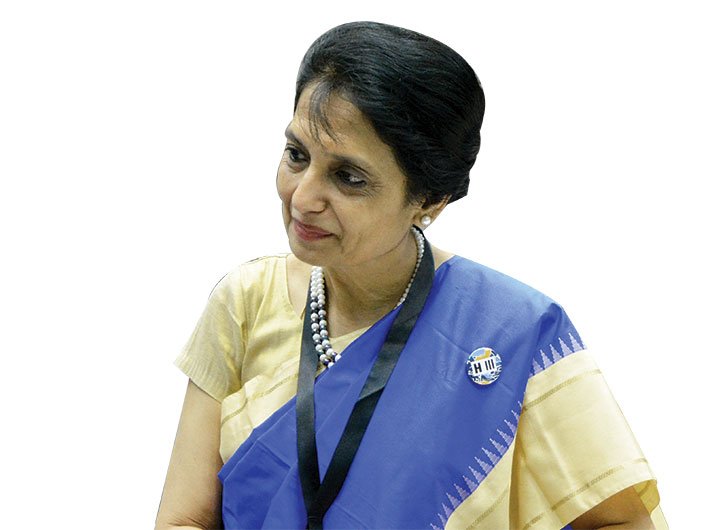If the prime minister’s vision comes true, by 2022 every family will have a pukka house with water and electricity connections. The Sardar Patel urban housing mission aims at making India slum-free in these seven years. Nandita Chatterjee, secretary, ministry of housing and urban poverty alleviation (MHUPA), talks to Puja Bhattacharjee about the challenges of ensuring housing for all. Excerpts:
How is the ministry of housing and urban poverty alleviation working towards providing housing for all by 2022?
We have seven years to ensure housing for all. Within this time we will make sure those beneficiaries who do not have a pukka house are able to afford their own pukka tenements for which we have four different policy pillars.
The first policy is in situ redevelopment. If in situ does not work then relocation has to be done with utmost care, as it is a question of people’s livelihood. Relocation has to be supported by infrastructure and transport.
AMRUT – The new avatar of JnNURM
Named after former prime minister Atal Bihari Vajpayee, the Atal mission for rejuvenation and urban transformation (AMRUT) aims at developing civic infrastructure in 500 cities and towns having population of 1,00,000 and above
AMRUT will have a corpus of '50,000 crore for the next five years (2015-16 to 2019-20)
Central support for funding of 398 sanctioned and partially completed JnNURM projects
Central help will be to the extent of 50 percent of the project cost for cities and towns with a population of up to 10 lakh and one-third of the project cost for those with a population of above 10 lakh
The central assistance will be released in three instalments in the ratio of 20:40:40 based on achievement of milestones indicated in state annual action plans
Under AMRUT, states get the flexibility of designing schemes based on the wants of identified cities and in their execution and monitoring
Project approach to ensure basic infrastructure services – water supply, sewerage, transport and development of green spaces, etc. – and promotion of urban reforms – e-governance, constitution of professional municipal cadre, devolving funds and functions to local bodies, review of building bye-laws, energy and water audit and urban planning, etc.
The second policy is through building affordable housing. Since land is a state subject, states can leverage the land and offer it through bids and reserve certain percentage of land for EWS (economically weaker sections) housing.
The third policy is credit-linked subsidy. The documentation process for issuing loans is tedious. We can facilitate it by ensuring speedy approval and single window clearance. For effective interest subvention, we are willing to give subsidy on interest rate.
The fourth policy is beneficiary-led construction. The government will give the beneficiary an upfront subsidy and the rest has to be borne by him.
What are the challenges in achieving this target?
The biggest challenge is limited resources of budget and land.
At present, what is the estimate of housing shortage?
The estimated housing shortage is 18.78 million. EWS is 56 percent (10.55 million), LIG (lower income group) is 40 percent (7.41 million) and MIG (middle income group) and above is 4 percent (0.82 million). Types of housing are: non-serviceable kutcha (shortage 0.99 million units), obsolescent houses (shortage 2.27 million units), congested houses requiring new houses (shortage 14.99 million units) and homeless condition (shortage 0.53 million units).
Investment required
₹ 50 lakh cr
Total investment required for various initiatives over the next few years
₹ 22.50 lakh cr
housing for all
₹ 16.50 lakh cr
urban infrastructure development
₹ 62,000 cr
urban sanitation
Which of these are you taking up on a priority basis?
Our first priority is to do away with slums. For that in situ livelihood promotion and forward and backward linkages to their new dwellings are essential. Another way could be parastatal bodies that can rehabilitate them in situ in one portion of the land and give the rest to the private sector according to developmental norms.
The average cost of EWS and LIG housing is Rs 6 lakh. Housing is affected by the play of market forces; the supply curve tends to be inelastic. Developers are not supplying at affordable rates. Affordable housing for the poor can be ensured by thorough action plans of the state government in core or non-core areas.
How can a state like Maharashtra, which is struggling with overcrowding in its capital, address the housing shortage?
Where there is a severe shortage of land, the state has to go either for vertical development or relocation to peri-urban areas.
What about the homeless?
There has to be an urban shelter policy for the homeless. They have to be first housed in shelters and then slowly make the transition to homes. We can give assistance to states for preparation of action plans in terms of issuing guidelines, policy and funding.
The size of EWS flats is often too small for a large slum-dwelling family. Have you considered increasing the size of these flats?
The guidelines state 30 square metres as an ideal size, but states have the complete flexibility to decide according to their requirements. The centre will not micro-manage, but if asked we can look into specific issues and frame policies accordingly.
Why are so many Rajiv awas yojana (RAY) dwellings lying vacant?
For the RAY houses lying vacant, the final list of beneficiaries is being prepared.
Most of the time beneficiaries sell off the houses given to them by the state and continue to live in their old tenements. How will you address this problem?
The government has to seriously consider providing homes instead of houses. If we make the woman the owner or the first holder of the tenement, chances of resale are less, as the woman will insist on the security of family. Also, by encouraging community participation of women by way of residents’ associations, pressure can be built against resale.
How will the Atal mission for rejuvenation and urban transformation (AMRUT) be different from the Jawaharlal Nehru national urban renewal mission (JnNURM)? Have the contours of the scheme been finalised?
AMRUT will be more focused. The scheme will target 500 cities with specific population benchmarks. Besides urban planning, it will also focus on increasing the green cover. Guidelines are yet to be issued but the scheme has in-principle approval.
puja@governancenow.com
(The interview appears in the May 16-31, 2015 issue)

